
Swedish study reveals that a third of pugs may suffer from problems walking
The pug is the UK’s third most popular dog breed overall, and there is a huge demand for dogs of the breed among puppy buyers, many of whom fall for the breed’s undeniably cute appearance and their charming personalities. However, the pug is also a dog breed that is well known to have higher than average incidence rats of a range of different and well-publicised health problems, including BOAS or brachycephalic obstructive airway syndrome, eye problems, and spinal deformities.
Whilst many pugs are perfectly healthy and buying a dog of the breed doesn’t necessarily mean buying into a lifetime of worry and expensive veterinary bills, the breed certainly has a high profile due to the number of different health problems found within the breed, and the large number of dogs of the breed affected by one or more of them.
Various studies and research programs have taken place – and are still ongoing – over the course of the last decade to build up a clearer picture of the breed’s health as a whole, its greatest challenges, and the potential for breed improvement.
The results of one of the most recently published studies is particular cause for concern, and touches upon a potentially breed-specific issue that doesn’t tend to receive as much attention as respiratory problems in pugs – their ability to walk comfortably and move normally.
This study took place in Sweden, and involved 550 different pugs whose owners were asked to complete a questionnaire about various different aspects of their health and mobility – and the results revealed that of the study’s participants, almost one in three of them have problems walking.
In this article we’ll look at the study in more detail, and examine what the results mean for pugs in the UK, and the future health of the breed as a whole. Read on to learn more.
What sort of dogs were examined within the study?
The study was undertaken by means of questionnaires distributed to Swedish pug owners who agreed to take part by answering a range of questions about their pug’s health, conformation, and day to day activities.
The pugs studied by the researchers were all registered pedigrees with the Swedish Kennel Club.
Results were collated for a total of 550 individual pugs, and all of the participating dogs were aged either one, five or eight. Choosing this specific range of ages allowed the study’s researchers to build up a profile of pug health from young adulthood through to maturity and the onset of old age, so that comparisons and contrasts could be made across the breed based on their life stage.
What information did the study collate?
The questions asked of pug owners as part of the study were designed to explore the incidence rate and type of gait abnormalities that affect pugs, in order to determine how common problems with movement and abnormal gait are within the breed, and how these problems are impacted by aging.
Pug owners were asked if they ever noticed their dog walking with an unusual gait, and if possible, to send in a video clip of their dog walking to support this. Pugs whose owners mentioned an unusual walking gait were asked to expand on this in more detail, such as by explaining if the dog was showing any signs of lameness, weakness, or ataxia (problems with balance and coordination) as well as whether their claws or paw pads were unevenly worn or overly worn down.
The study’s findings
The study’s eventual findings are interesting and enlightening, as well as rather concerning. From the sample total of 550 pugs within the study, 30.7% of them – or almost a third – were determined to have gait abnormalities, based on their owner’s responses and supporting information.
Pain accompanied this gait abnormality for many of the pugs studied, most commonly manifested as a reluctance to walk and exercise. The older the pug, the more likely they were to suffer from gait abnormalities and pain, which is concerning for owners of younger pugs as this indicates that there is a significant risk of problems of this type developing as the dog ages.
Interestingly, the pug’s well-publicised and common propensity to breathing difficulties appears to correlate to some degree with the development of gait abnormalities within the study population too.
Another important element of the results that the researchers concluded is that in contrast to what one might reasonably expect, the main cause for gait abnormalities within older pugs is likely to be due to neurological causes rather than physical problems such as bone and muscle aging and their age-related decline.
A quote from one of the researchers presenting the conclusions states that “The high prevalence of wearing nails reported in the questionnaires, and the fact that lameness was not a common finding in submitted videos, suggest that the majority of gait abnormalities in the pugs were indeed related to neurological rather than orthopaedic disorders.”
This information is naturally very concerning, and indicates the possibility that those well-publicised pug breathing difficulties may also come accompanied by gait and movement problems in older dogs too. How closely the results for the UK pug population would potentially mirror the Swedish results is something we don’t know – because to date, no equivalent study has been conducted across the UK pug population.
You can view the full details of the study as published in Veterinary Record here, and also find out more about the results and how this information will be used in future.



